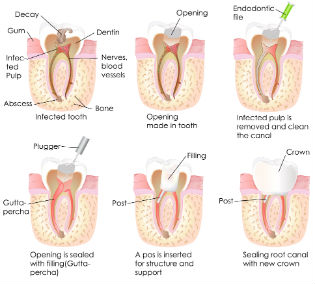Call: (608) 274-9556
Root Canals
Root canals have been around for a long time, and due to the improvements and advances in technology and modern materials, it is becoming easier to execute and more effective for patients who require them.

Root canals may be needed for a variety of reasons. Some patients that may require a root canal are those that:
- Have a dying nerve within the tooth
- Have extremely deep, large cavities
- Have had many different fillings that have irritated the tooth beyond the point where it can properly heal
- Have extreme stress on the tooth due to bite problems or clenching and grinding
- Have some kind of injury or trauma to the mouth
- Have an infection or abscess that develops around the tooth
- Have a toothache or extreme sensitivity to hot and cold due to a large cavity
The objective of a root canal is to remove the diseased tissue from inside of the tooth and to clean it out. This allows Drs. Madsen and Hirsch to place filling material within the tooth and seal it to avoid further problems. This is done in order to help save the natural tooth for the overall integrity of the entire mouth. When a patient starts to lose teeth, either from disease or extraction, many things start to change in the mouth to make certain situations worse. A root canal is done in order to save a tooth that might otherwise have to be extracted, and can result in additional problems within the mouth. Many patients who are at the point of requiring a root canal have one of two options: complete the root canal or have the tooth extracted.
For some patients, treatment may involve the prescription of antibiotics and anti-inflammatories, depending upon the individual situation. Infections will require additional medication and treatment in order to ensure it is completely eliminated before considering the full procedure.
The treatment itself is relatively painless, contrary to popular belief. Patients are fully anesthetized during the treatment, and if necessary, can be sedated for the procedure through nitrous oxide or oral sedation. Drs. Madsen and Hirsch will ensure that patients are completely comfortable before they proceed with the treatment to make sure that the procedure goes smoothly and comfortably for both patient and dentist.


